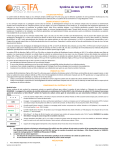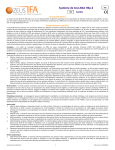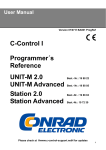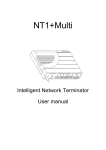Download Black Box LES1203A-11G Remote Starter User Manual
Transcript
© 2007. All rights reserved. Black Box Corporation. Black Box Corporation • 1000 Park Drive • Lawrence, PA 15055-1018 • Tech Support: 724-746-5500 • www.blackbox.com • e-mail: [email protected] PRO SWITCHING SYSTEM II Control hundreds or thousands of devices from a single ASCII terminal or PC! Key Features Chassis-mounted switching and patching system for RS-232, RS-530, X.21, and V.35 data communications. Cards for A/B switching and patching or for switchonly capabilities. Daisychain up to 9901 fully populated chassis to control and manage up to 158,416 A/B interface cards. Management Control Software makes onscreen control a snap. Multiple programmable alarms alert you to network conditions. Dual-power options. 1 12/18/2007 #25900 anaging switchable circuits is easy with the Pro Switching System II (PSSII) from Black Box. This innovative system consists of rackmount modular components that provide an economical and reliable means to manage RS-232/V.24, V.35, X.21, and RS-530 data interfaces. With this chassismounted switching and patching system, you can switch individual circuits, all 16 circuits in a chassis, or a group of circuits via remote console commands or upon an alarm automatically. You can also switch manually. Use front-panel buttons to switch individual circuits or to gangswitch. Or you can disable manual switching capabilities in the system with a simple command from an attached console. We even offer a Contact Closure Card that lets you use a programmable logic controller (PLC) to direct your circuit switching. Daisychain up to 9901 chassis together to control and manage 158,416 A/B interface cards from M a single console. This means of control is an alternative to connecting multiple multiport KVM switches when you want to manage hundreds of CPUs. One PSSII console can support 32,000 switchable circuits in 2000 racks (if you install 100 racks at each of 20 sites). In this setup, each site would contain one master rack which, in turn, would support up to 99 slave chassis. And you’re not limited by a type of cabling that can be used to connect the console to the master chassis; it can be local hard-wired cabling, a dedicated link, or even a dialup link (although you must use hard-wired local cabling for all slave connections). The PSSII chassis At the heart of the system is the chassis. Choose the SM900A for RS-232, RS-530, X.21, or V.35 communications. For V.35 only, use the SM901A. Each chassis has 18 mounting slots with card guides and a backplane PC board that provides the card-edge interface for the cards you plan to add. The rear plate of the chassis has three rows of DB25 EIA connectors. Use them to attach the A, B, and Common (modem) sides of your data cables. Cards seat in the chassis from the front, and their data connectors plug easily into the cable connectors without disturbing any cable bundles attached at the chassis’ rear. The first slot holds the unit’s Power Supply Modules (order separately), and the slot adjacent to it is for installing an optional Management Control Card or Terminal Display Card. The chassis’ other 16 slots can accommodate up to 16 circuit cards, which we offer as Front Interface Cards or Universal Serial Cards. Each module passes one switchable data circuit. The PSSII chassis also has a control-communications interface and two test-equipment interfaces. The latter two connections enable you to perform interactive test(continued on page 2) The front and back views of a Pro Switching System II chassis. (2) Power Supplies (1) Management Control Card (16) Front Interface Cards (Slot is also used for Terminal Display Card) (Slots are also used for Universal Serial Cards) All modules mount in a Pro Switching System II chassis for installation in a standard 19-inch rack. The chassis includes a six-foot (1.8-m) AC power cord. Standard AC voltage is 115- or 230-volt input. The redundant front-loaded power supplies (to be ordered separately) provide DC-voltage power to the chassis. Attaching ears are slotted at the standard EIA location for a 7" panel. The Management Control Card (also to be ordered separately) contains LEDs that indicate signal status of any interface patched to the controlmodule cavity from a patch cavity. The LEDs illuminate with a positive voltage, such as a data “space” or a control signal “high.” Next to each LED are voltage-test jacks. (continued from page 1) module communications and test functions. You can use the interface labeled ”I/A”, for instance, to connect a basic error rate (BER) tester or a protocol analyzer. In addition to BER tests, you can conduct protocol simulation, block error rate (BLER) tests, or error-free seconds (EFS) tests. The other test interface, labeled “Monitor,“ enables you to connect a data-line monitor device when you want to passively monitor certain lines. The interface’s parallel-wired connectors are also used to daisychain two or more PSSII chassis. Modules for the system For your various interface requirements, we offer a number of modular cards (also called circuit cards) that can be installed in a PSSII chassis. Each card is a single switchable circuit between your data terminal equipment (DTE) and data communications equipment (DCE), and feature circuit-status display and alarm definition, detection, and reaction. The cards are equipped with three ports that link to A, B, and 2 Common paths. These paths connect to the equipment cables attached in at the chassis’ rear. You can switch paths, for instance, when you need to reroute a circuit from an attached device that has failed to a device or circuit that’s operational. To switch, press a button on the mounted card. LEDs inform you of your selected switch position. Each card has four manual patch cavities. Three of these provide intrusive access to the A, B, and Common (modem) sides of the switchable circuit. The fourth cavity provides bridged (nonintrusive) access to the Common (modem) side. RS-232, RS-530, X.21, and V.35 Front Interface Cards, (SM906C–SM909C) feature a switchable A/B circuit, a common RS-232 or V.35 cable connection, plus signal-monitoring LEDs. You can mix, match, and install up to 16 cards in the chassis. With up to nine alarm options, each RS-232, RS-530, and V.35 circuit can be individually configured for up to a maximum of eight alarms on the presence or absence of Physical Layer signals. And each X.21 circuit can be individually configured for up to six programmable alarms. If you don’t require patching capabilities but want economical A/B switching plus transfer speeds of 10 Mbps! within your PSSII, order Universal Serial Cards (SM930C–SM934C). These cards support RS-232, V.35, RS-530, X.21, 10BASE-T, and analog RJ-11 or RJ-45 communications. They differ only in the interface adapters shipped with them (except for the SM930C, which is designed to link to the chassis’ three DB25 connectors and, therefore, requires no adapters). The SM930C is a universal DB25 model that’s suitable for RS-232 or RS-530 switching applications. The SM931C has three DB25 male to DB9 female adapters. It’s ideal for RS-232 TIA-574 (IBM PC COM port) switching applications. The SM932C has three DB25 male to DB15 female adapters and is suitable for X.21 switching. The SM933C has three DB25 male to RJ-11 female adapters and is suitable for 4-wire RS-422 applications or can be used to switched telephone circuits not connected to the public telephone system. The SM934C, which features RJ-45 connectors that are RJ-48 compatible and are unkeyed, ® includes three DB25 male to RJ-45 female adapters. It’s suitable for RS-232 TIA-561, 8-wire RS-422, 10BASE-T, or Token Ring (up to 16 Mbps) applications. It can also be used to switch private T1 or E1 circuits not connected to the public telephone system. With its latching relay feature, the Universal Serial Card forwards all traffic in the event of a power failure and, when used as a copper path, operates independent of speed and protocol. And there’s no complicated programming! As with the Front Interface Cards, the Universal Serial Cards install in the front of the PSSII chassis and can even be mounted alongside the Front Interface Cards. In a daisychain configuration, you can put up to 16 Front Interface or Universal Serial Cards in each slave chassis. The master chassis can be populated with up to 16 of these cards plus one Terminal Display Card. Management cards For managing the chassis, you’ll need either a Management Control Card or a Terminal Display Card. The Management Control Card (SM902C or SM904C) provides (continued on page 3) (continued from page 3) the logical bridge between the interface cards and the consolegenerated commands. Order the SM902C card for the SM900A chassis and the SM904C card for the SM901A chassis. The Management Control Card supports console-controlled datacircuit alarming and includes a full array of LED signal-status indicators and voltage-test points. With the card, switching commands are received from the PSSII and relayed to the appropriate rackmounted circuit cards. These commands can be for individual circuits, all circuits within a rack, or specific circuits that are part of a user-defined circuit group, whether they originate from a realtime console entry or they’re generated automatically when an alarm occurs. If you’re looking to configure the chassis from various locations while using an attached ASCII terminal, you’ll need the Terminal Display Card, available for the RS-232, RS-530, X.21, V.35 chassis (SM903C) or V.35-only chassis (SM905C). With this card, you can program the system to switch circuits at a specified time— automatically. This is a particularly useful capability when, for example, you need to redirect incoming calls at the office at a certain time of the day. You can also use the Terminal Display Card to control a group of the circuit cards in a gang-switch capacity. The Terminal Display Card package includes the DB25 to RJ-45 card, an RJ-45 to RJ-45 cable, and a DB25 to RJ-45 adapter. Management software. The Management Control Software enables the PSSII to be configured to place outgoing calls and receive incoming calls from sites equipped with one or more PSSII chassis. What’s more, the software provides you with the ability to examine any portion of your enterprise network at any desired level of detail. In addition, the utility advises you of any major occurrence anywhere within the network. 3 The software’s interface displays on-screen alarm conditions with a date and time stamp. A color-coded signal also shows the status of any circuit in the network, and you can view signal status for an entire chassis. The software’s Circuit Configuration menu is the way you assign circuits to and from a ”group,“ which is defined as a logical collection of circuits without regard to their location within the Pro Switching System II. All switchable circuits within a specific group can be switched by either console command or automatically upon alarm. Manual Contact Closure Card To provide both manual and contact closure gang-switching capabilities to your system, order the Manual Contact Closure Card (SM916C). This card enables you to patch a programmable logic controller (PLC) to the straightthrough Monitor interface connector on the chassis. The PLC , in turn, is used to switch all circuits in the chassis from A to B and back again automatically. Not only can you use the card with a PLC to close contacts, but you can disable specific cards seated in the chassis using the card’s DIP switches. To manually reverse all switch positions in the master chassis, you need only to press a lamp-test button at the top of the card. Unlike other cards designed for the PSSII, the Manual Contact Closure Card does not support terminal or PC management. It has a signal-status LED display and two patch cavities. The upper cavity provides a straight-through connection to the LED display and to a DB25 I/A interface on the chassis, while the other provides a straight-through connection to the Monitor interface connector. Other PSSII components For using external test equipment with your Pro Switching System II, order an optional 6-foot (1.8-m) Test Cord. The RS-232 version (SM917) attaches the system to RS-232 or RS-530 equipment, while the V.35 model (SM918) attaches the system to V.35 equipment. For standard nonintrusive testing, you would run the cord from the bottom Monitor port patch cavity on a PSSII chassis to the DB25 or M/34 connector on your test equipment. You can also use the Test Cords for intrusive testing that breaks the normal signal paths and routes the Port A or B or modem port signals to the external equipment. You’ll also need to equip your chassis with one or two Power Supply Modules (SM950A or SM950A-220). Using two supplies makes your system more reliable: if one module fails, the other kicks in to keep the PSSII operating as normal. Failure of either Power Supply Module will trigger a console alert, although one module can provide enough power to a full chassis. If you choose to use only one Power Supply Module, be sure to order a Blank Cover for an Unused Power Supply Slot (SM911C). This is a protective metal strip that fits over the empty slot at the rack’s rear and helps keep the chassis internal parts free of dust and other particles. We also offer covers for unused circuit card slots in the rack. As with the SM911C, the Blank Cover for an Unused Interface Slot (SM910C) includes screws for securing it to the chassis. All empty module slots on the chassis should be filled with these blank panels. Doing this will help to prevent damage from occurring to the installed modules and the chassis components. Software System Requirements • Pentium 1 or better processor. • CD-ROM drive. • An available serial port for Pro Switching System II connections to one or more sites. Additional serial ports are necessary if additional sites are to be supported without serial-port sharing. (NOTE: If additional serial ports are to be added, please call Black Box Tech Support.) • 4.64 or more MB of RAM. • Windows 95/98 or Windows NT (Windows 2000 and Windows XP are not supported.) ® ® ® Specifications Data Format: 8-bit data, 1 stop bit, no parity Management Method: Via ASCII terminal or software Management Controls: Terminal control: Send Data, Receive Data, Serial Clock Transmit, Serial Clock Receive, Request to Send, Data Terminal Ready, Data Carrier Detect, Data Set Ready; GUI control: Send Data, Receive Data, Serial Clock Transmit, Serial Clock Receive, Request to Send, Data Terminal Ready, Data Carrier Detect, Clear to Send Programmed Alarms: RS-232, RS-530, V.35: Send Data, Receive Data, Serial Clock Transmit, Serial Clock Receive, Request to Send, Data Terminal Ready, Data Carrier Detect, Data Set Ready, Clear to Send; X.21: Transmit Data, Receive Data, Indicate, Control, Signal Element Timing, Byte Timing Protocols: Transparent Speed: Terminal control: 1200, 2400, 4800, or 9600 bps; 19.2 kbps; GUI control: 1200, 2400, 4800, or 9600 bps CE Approval: Yes Interface: SM900A: RS-232, RS-530, X.21, V.35; SM901A: V.35 Connectors: SM900A: (48) DB25 F, (3) per circuit; (2) DB25 F for monitor; (1) DB25 F for I/A test; (1) DB25 F for control in/out; SM901A: (48) M/34 F, (3) per circuit; (2) DB25 F for monitor; (1) DB25 F for I/A test; (1) DB25 F for control in/out Operating Environment: Temperature: 32 to 104°F (0 to 40°C); Humidity: 10 to 80% noncondensing Power: 110/220 VAC, 60/50 Hz, internal, with IEC 320 connector (chassis can hold [2] front-loaded power supply modules) Size: 7"H (4U) x 19"W x 14"D (17.8 x 48.3 x 35.6 cm) Weight: SM900A: 29 lb. (13.2 kg) fully loaded; SM901A: 39 lb. (17.7 kg) fully loaded Ordering Information ITEM CODE First, order the chassis for your application… Pro Switching System II Chassis RS-232, RS-530, X.21, V.35 ....................................SM900A V.35 Only ...................................................................SM901A …next, order one or two power supplies… Power Supply Modules 110-VAC ....................................................................SM950A 220-VAC ............................................................SM950A-220 …then, select either a control card… Management Control Cards RS-232, RS-530, X.21, V.35.....................................SM902C V.35 Only ...................................................................SM904C …or a display card for your master chassis… Terminal Display Cards RS-232, RS-530, X.21, V.35.....................................SM903C V.35 Only ...................................................................SM905C …and cards… Front Interface Cards RS-232 .......................................................................SM906C V.35.............................................................................SM907C RS-530 .......................................................................SM908C X.21.............................................................................SM909C Universal Serial Cards RS-232 (DB25)..........................................................SM930C DB9 Serial ................................................................SM931C DB15 Serial ..............................................................SM932C RJ-11 (4-Wire) .........................................................SM933C RJ-45 (8-Wire) .........................................................SM934C 4 ITEM CODE For manual and contact-closure switching, order… Manual Contact Closure Card.................................SM916C To manage the Pro Switching System II, order… Management Control Software..............................SM912A For empty slots, order… Blank Cover for an Unused Interface Slot ...............................SM910C for an Unused Power Supply Slot..........................SM911C For connecting test equipment, order… Test Cords for DB25.......................................................................SM917 for V.35 .........................................................................SM918 You may also want to order cable… Category 5 Patch Cable, 100-MHz, 4-Pair, Straight-Pinned, PVC, Beige, 10-ft. (3-m)................................................EVMSL05-0010 RS-232 Cable, 25-Conductor, 10-ft. (3-m)....ECM25C-0010 V.35 Interface Cable, 10-ft. (3-m), Male/Male .............................................EYN450-0010-MM You may also need… Modular Adapter Kits DB25 Male↔RJ-11 Female 4- or 6-Wire..............FA024 DB25 Male↔RJ-45 Female 8-Wire........................FA025












